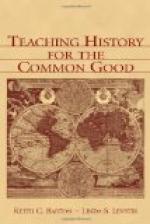Having secured, by class discussion and the work at the board, satisfactory answers to the first six questions, and having assigned the lesson for the next day, the remainder of the hour and, if necessary, the rest of the week should be spent in outlining for the student a method of study. That very few students of high school age possess habits of systematic study, needs no discussion. In spite of all that their grade teachers may have done for them, their tendency is to pass over unfamiliar words, allusions, and expressions, without troubling to use a dictionary. The average high school student will not read the fine print at the bottom of the page, or use a map for the location of places mentioned in the text without special instruction to do so. He will set himself no unassigned tasks in memory work. It is the first business of the good instructor to teach the student how to study. The first step in this process is to impress on the student’s mind that systematic preparation in the history class is as necessary as in Latin, physics, or geometry. Then let the following or similar instructions be given him:—
1. Provide yourself
with an envelope of small cards or pieces of
note
paper. Label each with the subject of the lesson
and the
date
of its preparation. These envelopes should be
always at
hand
during your study and preparation. They should
be preserved
and
filed from day to day.
2. Read the lesson
assigned for the day in the textbook, including
all
notes and fine print.
3. Write on a sheet
of note paper all the unfamiliar words,
allusions,
or expressions. Later, look these up in the
dictionary
or other reference.
4. Record the dates which you think worthy to be remembered.
5. Discover and
make a note of all the apparent contradictions,
inconsistencies,
or inaccuracies in the author’s statements.
6. Use the map
for all the places mentioned in the lesson. Be
able
to
locate them when you come to class.
7. In nearly every
text there is a list of books for library use,
given
at the beginning or end of each chapter. Make
yourself
familiar
with this bibliography.
8. Read the special questions assigned for the day by the teacher.
9. Go to the library.
If the book for which you are in search is
not
to be found, try another.
10. Learn to use an index.
If the topic for which you are looking
does
not appear in the index, try looking for the same thing
under
another name; or under some related topic.
11. Having found the
material in one book, use more than one if
your
time permits. When you feel that you have secured
the
material
which will make a complete answer to the question,
write
the answer on one of your cards for keeping notes.




